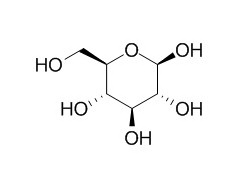D-(+)-Glucose
Dextrose, a simple sugar (monosaccharide), is an important carbohydrate in biology, it exhibits marked antibacterial activity against Staphylococcus aureus,Escherichia coli and Pyocyanine. D-(+)-Glucose can prevent MPP+ toxicity, attenuate the loss of ATP, but do not reverse the complete inhibition of mitochondrial O2 consumption (MOC).
Inquire / Order:
manager@chemfaces.com
Technical Inquiries:
service@chemfaces.com
Tel:
+86-27-84237783
Fax:
+86-27-84254680
Address:
1 Building, No. 83, CheCheng Rd., Wuhan Economic and Technological Development Zone, Wuhan, Hubei 430056, PRC
Providing storage is as stated on the product vial and the vial is kept tightly sealed, the product can be stored for up to
24 months(2-8C).
Wherever possible, you should prepare and use solutions on the same day. However, if you need to make up stock solutions in advance, we recommend that you store the solution as aliquots in tightly sealed vials at -20C. Generally, these will be useable for up to two weeks. Before use, and prior to opening the vial we recommend that you allow your product to equilibrate to room temperature for at least 1 hour.
Need more advice on solubility, usage and handling? Please email to: service@chemfaces.com
The packaging of the product may have turned upside down during transportation, resulting in the natural compounds adhering to the neck or cap of the vial. take the vial out of its packaging and gently shake to let the compounds fall to the bottom of the vial. for liquid products, centrifuge at 200-500 RPM to gather the liquid at the bottom of the vial. try to avoid loss or contamination during handling.
Biosci. Rep.2020, 10.1024
Front Chem.2024, 12:1385844.
J Ethnopharmacol.2024, 318(Pt B):116961.
FEBS Lett.2021, 595(20):2608-2615.
Biochem Pharmacol. 2020, 177:114014.
Anal Chim Acta.2018, 1039:162-171
Int J Mol Sci.2021, 22(16):8604.
Phytochem Anal.2016, 27(5):296-303
Int J Mol Sci.2018, 19(9):E2601
Mol Biol Rep.2024, 51(1):117.
Related and Featured Products
Food Chem . 2015 May 15;175:485-93.
D-glucose, D-galactose, and D-lactose non-enzyme quantitative and qualitative analysis method based on Cu foam electrode[Pubmed:
25577110]
Abstract
Here, D-glucose, D-galactose, and D-lactose non-enzyme quantitative and qualitative analysis method using Cu foam electrode had been investigated. Porous Cu foam material was prepared by electrodeposition strategy, and used as working electrode. Cyclic voltammetry (CV) explained sweetener electro-oxidation process occurring on Cu foam electrode. Amperometric i-t scanning results demonstrated that Cu foam electrode fast responded to D-glucose, D-galactose, and D-lactose in linear concentration range between 0.18 mM and 3.47 mM with significant sensitivity of 1.79 mA cm(-2)mM(-1), 0.57 mA cm(-2)mM(-1), and 0.64 mA cm(-2)mM(-1), respectively. Limit of detection (LOD) was 9.30 μM, 29.40 μM, and 26 μM respectively (S/N=3). Sweetener species was decided by stochastic resonance (SR) signal-to-noise ratio (SNR) eigen peak located noise intensities. Interference experiment results demonstrated that Cu foam electrode selectively responded to sweeteners against interference chemicals. The proposed method provides a promising way for sweetener non-enzyme quantitative and qualitative analysis.
Keywords: Cu foam; Non-enzyme; d-Galactose; d-Glucose; d-Lactose.
Brain Research Volume 962, Issues 1–2, 7 February 2003, Pages 48–60
d-(+)-Glucose rescue against 1-methyl-4-phenylpyridinium toxicity through anaerobic glycolysis in neuroblastoma cells[Reference:
WebLink]
The active neurotoxin of 1-methyl-4-phenyl-1,2,3,6-tetrahydropyridine (MPTP), 1-methyl-4-phenylpyridinium (MPP+), exerts its lethal effect by inhibiting Complex I of the electron transport chain (ETC). MPP+ shuts down aerobic oxidative phosphorylation and ETC-mediated ATP synthesis.
METHODS AND RESULTS:
The present investigation examines anaerobic survival during MPP+ toxicity in murine neuroblastoma cells Neuro 2-A (N2-A). MPP+ addition to the cells resulted in a reduction in cell viability, mitochondrial O2 consumption (MOC) and ATP concentration in a dose-dependent manner. However, the addition of 10 mM of D-(+)-Glucose prevented MPP+ toxicity, attenuated the loss of ATP, but did not reverse the complete inhibition of MOC, indicating substrate level phosphorylation and explicit anaerobic survival. Glucose addition prevented MPP+-mediated drop in ΔΨm, endoplasmic reticulum and intracellular organelle membrane potential tantamount to an increase of cell viability. Secondly, we examined the metabolic regulation of pyruvate dehydrogenase (PDH) and carnitine palmitoyl transferase (CPT) activities during glucose rescue. These enzymes exert control over acetyl CoA reservoirs in the mitochondria during aerobic metabolism. dl-6,8-Thioctic acid (PDH prosthetic group) and insulin slightly augmented metabolic rate, resulting in enhanced vulnerability to MPP+ in a glucose-limited environment. Additional glucose prevented these effects. Amiodarone (CPT inhibitor) and glucagon did not hamper or potentiate glucose rescue against MPP+. These data support strict anaerobic glucose utilization in the presence of toxic levels of MPP+. Moreover, the findings indicate that MPP+ exerts two distinct modes of toxicity (fast and slow death). With MPP+ (<1 mM), anaerobic glycolysis is operational, and toxicity is strictly dependent upon glucose depletion. MPP+ (1–10 mM) initiated acute metabolic collapse, with failure to sustain or switch to anaerobic glycolysis.
CONCLUSIONS:
In conclusion, overcoming energy failure against MPP+ may involve targeting rate-limiting controls over anaerobic energy pathways.
Tetrahedron,2000,11(23): 4701-8.
Synthesis of novel diphosphines from d-(+)-glucose. Use in asymmetric hydrogenation[Reference:
WebLink]
A new family of bidentate diphosphine ligands which contain a glucofuranoside as a simple but highly effective chiral backbone are reported. These ligands are prepared in a few steps from readily available D-(+)-Glucose.
CONCLUSIONS:
These new ligands have been applied to the rhodium-catalysed hydrogenation of α,β–unsaturated carboxylic acid derivatives under very mild reaction conditions, with enantiomeric excesses of up to 98%.
Academic Forum of Nan Du, 2001.
Synthesis and Antibacterial Activity of Cu(Ⅱ) Complexes With D-(+)-Glucose Thiosemicarbazone[Reference:
WebLink]
METHODS AND RESULTS:
Cu(C 7H 15 N 3O 5S)SO 4]solide complex has been synthesized by the reaction of D-(+)-Glucose thiosemicarbazone with copper sulfate.The formula and structure were confirmed by the chemical analysis,elemental analysis and IR spectrum.
CONCLUSIONS:
The complex exhibits marked antibacterial activity against Staphylococcus aureus,Escherichia coli and Pyocyanine.



